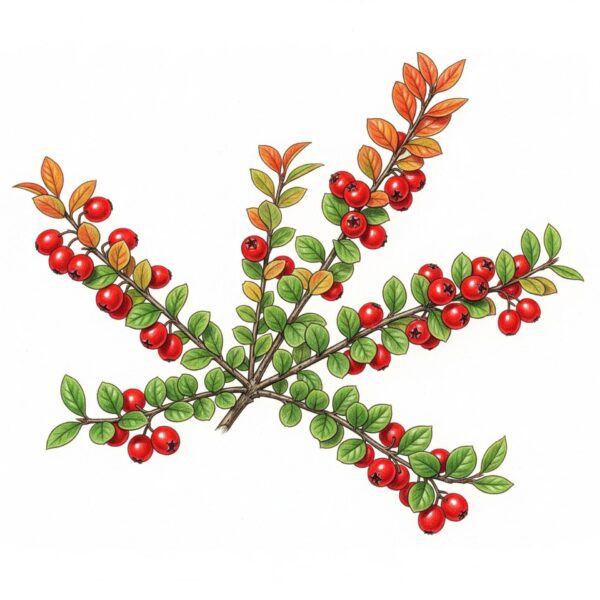Key Characteristics
- Size: It typically grows to a height of 2 to 3 feet (about 60-90 cm) with a much wider spread of 6 to 8 feet (1.8-2.4 m), creating a dense, mat-like appearance.
- Branches: The most notable feature is its stiff, flattened, horizontal branches that grow in a striking “herringbone” or “fishbone” pattern. When trained against a wall, this pattern becomes very prominent.
Foliage:
- Leaves: The small, glossy, dark green leaves are round or broadly oval and up to about half an inch long.
- Autumn Color: In autumn, the leaves put on a brilliant display, turning shades of orange, reddish-purple, and scarlet before they fall. The leaves can persist for a long time, often remaining on the plant well into winter.
Flowers and Fruit:
- Flowers: In late spring to early summer (typically May to June), the plant is covered in tiny, five-petaled, pinkish-white flowers that appear singly or in pairs. These flowers are an excellent source of nectar and are highly attractive to bees and other pollinators.
- Fruit: The flowers are followed by an abundance of bright scarlet, spherical berries (pomes) that are about a quarter-inch wide. These berries ripen in late summer to autumn and can persist on the bare branches throughout the winter, providing a vibrant splash of color and a food source for birds. The berries are not edible for humans.
Growing Conditions and Uses
- Sun and Soil: Cotoneaster horizontalis is a tough and adaptable plant. It grows best in well-drained, moderately fertile soil but can tolerate a wide range of soil types, including chalk, clay, and sand. It thrives in full sun but will also grow in partial shade, though it may produce fewer flowers and berries in less light.
- Hardiness: This shrub is very hardy and can withstand cold winters (RHS H7 hardiness rating) as well as periods of drought once established. It is also tolerant of urban pollution and coastal conditions.
- Landscaping Uses: Its primary uses are as a woody groundcover for slopes and banks, in rock gardens, or espaliered against walls and fences. Its low-maintenance nature and seasonal interest make it a valuable plant for various garden designs.
Other Information
- Common Names: In addition to rockspray cotoneaster, it is also known as wall cotoneaster.
- Native Range: The plant is native to western China.
- Invasiveness: In some regions, particularly England and Wales, it is listed on Schedule 9 of the Wildlife and Countryside Act, which makes it an offense to plant it or cause it to grow in the wild due to its invasive potential.

